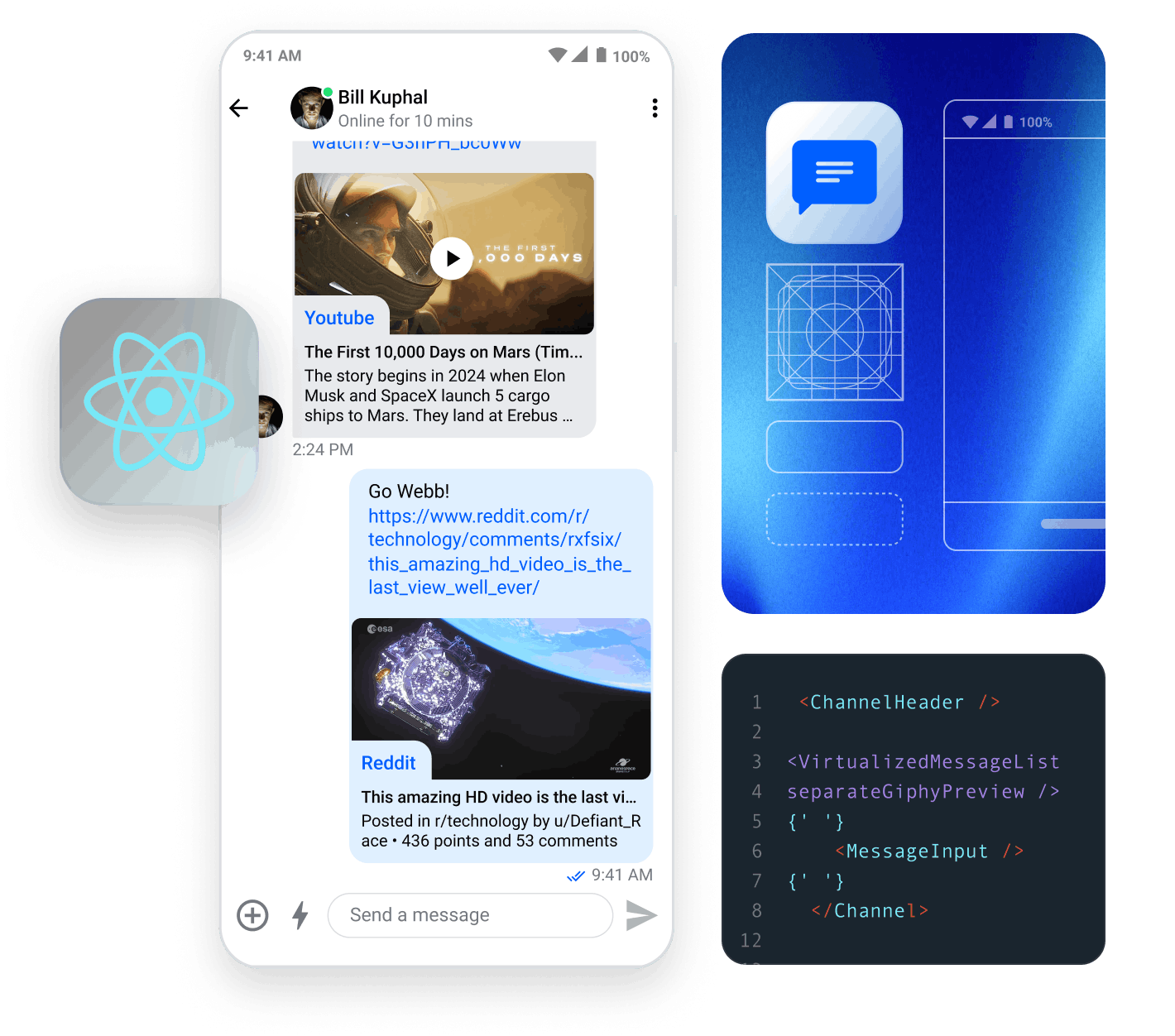Create App And Install Dependencies
To get started with this tutorial, make sure you have set up your development environment for React Native.
To get started, create an application with the Expo CLI and install the necessary dependencies:
12345# Initialize the app with the Expo CLI npx create-expo-app MyStreamChatApp --template blank # Navigate to the app directory cd MyStreamChatApp
Stream Chat has a number of peer dependencies that are required, to take advantage of all of the out of the box features. It is suggested you follow the install instructions for each package to ensure it is properly setup.
123# Add Stream Chat Expo SDK npx expo install stream-chat-expo
123# Add the listed dependencies npx expo install @react-native-community/netinfo expo-file-system expo-image-manipulator react-native-gesture-handler react-native-reanimated react-native-svg
Add Optional Dependencies
Image Media Library Picker
Access and upload image using an inbuilt image picker in the SDK.
1npx expo install expo-media-library
Native Image Picker
Access and upload image using an native image picker.
1npx expo install expo-image-picker
File picker
Access the file picker and upload the file.
1npx expo install expo-document-picker
Camera Picker
Access the camera and upload the image.
1npx expo install expo-image-picker
Video Support
Installing this package allows you to play the video and audio files/attachments in the chat. Otherwise by default, video and audio files will be opened and downloaded through the default browser of the device.
1npx expo install expo-av
Haptic Feedback
Enables haptic feedback when you perform any actions in the chat application.
1npx expo install expo-haptics
Attachment Sharing
Installing this package will allow your users to share attachments from the gallery using the native sharing interface on their devices.
1npx expo install expo-sharing
Copying messages
Adds ability to copy messages to the clipboard.
1npx expo install expo-clipboard
Audio Recording and playback
Adds ability to record and play audio messages.
1npx expo install expo-av
Offline support
Adds offline support to the chat application.
1npx expo install @op-engineering/op-sqlite
Application level setup
The most important steps to get started are:
- Add the Babel plugin for
react-native-reanimatedto yourbabel.config.jsfile in your application folder:
1234567module.exports = { ... plugins: [ ... 'react-native-reanimated/plugin', // Reanimated plugin has to be listed last. ], };
- Import
react-native-gesture-handlerat the top of your project(say_layout.js, if you useexpo-router). It should look as follows:
1234567import "react-native-gesture-handler"; import { AppRegistry } from "react-native"; import App from "./App"; import { name as appName } from "./app.json"; AppRegistry.registerComponent(appName, () => App);
Now you should be able to run the app on simulator by running following command:
1yarn run ios # or npx react-native run-ios
1yarn run android # or npx react-native run-android
Setup Basic Navigation
The Stream Chat SDK does not handle navigation, but we can use expo-router to setup basic navigation for the app.
Please install the following packages to get started with Expo Router, as mentioned in their documentation.
12# Install expo-router and other dependencies npx expo install expo-router react-native-safe-area-context react-native-screens expo-linking expo-constants expo-status-bar
After this step, please follow the steps mentioned in the Expo Router documentation to setup the basic navigation for the app. This involves crucial steps like setting up the entry point, adding scheme for deep linking and adding babel config.
We'll set up a simple stack navigation to hold the necessary screens for navigation in our app, and start with a basic HomeScreen, which we will replace later with Chat related screens.
To do that, you can use the Stack component from expo-router in your app/_layout.js file, as follows:
123456import "react-native-gesture-handler"; import { Stack } from "expo-router"; export default function App() { return <Stack />; }
We will then create an index.js file as below and this will be the entry screen for our app.
12345678910111213141516171819import { StatusBar } from "expo-status-bar"; import { StyleSheet, Text, View } from "react-native"; export default function Home() { return ( <View style={styles.container}> <Text>Home Screen</Text> <StatusBar style="auto" /> </View> ); } const styles = StyleSheet.create({ container: { flex: 1, alignItems: "center", justifyContent: "center", }, });
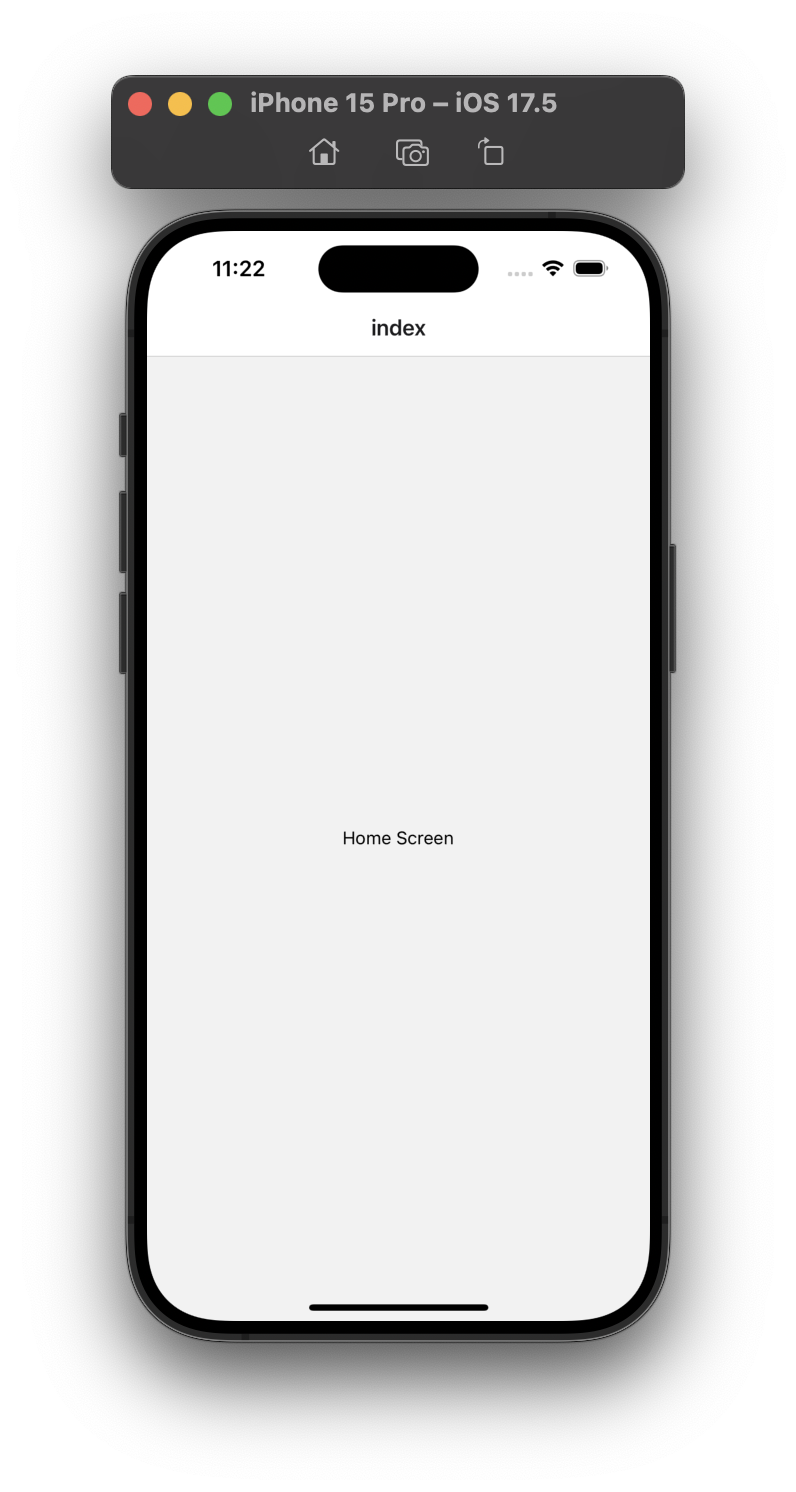
As mentioned in RNGH documentation, we also need to configure GestureHandlerRootView component. Although react-navigation library already use GestureHandlerRootView as a wrapper to enable gesture interactions. So for this tutorial, you don't need this step. But if you are using a native navigation library like wix/react-native-navigation you need to make sure that every screen is wrapped with GestureHandlerRootView.
1234567891011121314151617181920import { StyleSheet } from "react-native"; import { GestureHandlerRootView } from "react-native-gesture-handler"; import { SafeAreaProvider } from "react-native-safe-area-context"; import { Stack } from "expo-router"; export default () => { return ( <SafeAreaProvider> <GestureHandlerRootView style={styles.container}> <Stack /> </GestureHandlerRootView> </SafeAreaProvider> ); }; const styles = StyleSheet.create({ container: { flex: 1, }, });
Add Stream Chat to the application
Before we begin working with the chat UI components we'll need to set up a StreamChat client which abstracts API calls into methods, handles state and real-time events. To make the instantiation and connection handling easier, we've prepared a simple hook (useCreateChatClient) that you can use in your application.
You can find apiKey on an GetStream dashboard for your app. You can create token for authentication using this link for a specific user id.
1234export const chatApiKey = "REPLACE_WITH_API_KEY"; export const chatUserId = "REPLACE_WITH_USER_ID"; export const chatUserName = "REPLACE_WITH_USER_NAME"; export const chatUserToken = "REPLACE_WITH_USER_TOKEN";
And now we can use these configs to create a client and connect the user to chat as follows:
123456789101112131415161718192021222324252627282930313233import React from "react"; import { Text } from "react-native"; import { SafeAreaView } from "react-native-safe-area-context"; import { useCreateChatClient } from "stream-chat-expo"; import { chatApiKey, chatUserId, chatUserName, chatUserToken, } from "../chatConfig"; const user = { id: chatUserId, name: chatUserName, }; export const ChatWrapper = ({ children }) => { const chatClient = useCreateChatClient({ apiKey: chatApiKey, userData: user, tokenOrProvider: chatUserToken, }); if (!chatClient) { return ( <SafeAreaView> <Text>Loading chat ...</Text> </SafeAreaView> ); } return <>{children}</>; };
Note: Make sure you use the
useCreateChatClienthook only once per application. If you need the client instance somewhere down in the component tree use theuseChatContexthook (exported by thestream-chat-react) to access it.
To use the connected client, we wrap the content of the app/_layout.js with the above ChatWrapper:
123456789101112131415161718192021222324import { StyleSheet } from "react-native"; import { GestureHandlerRootView } from "react-native-gesture-handler"; import { ChatWrapper } from "../components/ChatWrapper"; import { SafeAreaProvider } from "react-native-safe-area-context"; import { Stack } from "expo-router"; ... export default function Layout() { return ( <SafeAreaProvider> <GestureHandlerRootView style={styles.container}> <ChatWrapper> <Stack /> </ChatWrapper> </GestureHandlerRootView> </SafeAreaProvider> ); } const styles = StyleSheet.create({ container: { flex: 1, }, });
Creating the App context
A context should ideally be created to store the details of the current Channel and the Thread as set by the user on selecting the Channel from the ChannelList or Thread from the MessageList.
We will create the context AppContext such as:
123456789101112131415161718192021import React, { useState } from "react"; export const AppContext = React.createContext({ channel: null, setChannel: (channel) => {}, thread: null, setThread: (thread) => {}, }); export const AppProvider = ({ children }) => { const [channel, setChannel] = useState(); const [thread, setThread] = useState(); return ( <AppContext.Provider value={{ channel, setChannel, thread, setThread }}> {children} </AppContext.Provider> ); }; export const useAppContext = () => React.useContext(AppContext);
To use the context we wrap the default component of the _layout.js file with AppProvider as follows:
123456789101112131415161718192021222324252627import { StyleSheet } from "react-native"; import { GestureHandlerRootView } from "react-native-gesture-handler"; import { SafeAreaProvider } from "react-native-safe-area-context"; import { Stack } from "expo-router"; import { ChatWrapper } from "../components/ChatWrapper"; import { AppProvider } from "../contexts/AppContext"; ... export default function Layout() { return ( <SafeAreaProvider> <GestureHandlerRootView style={styles.container}> <ChatWrapper> <AppProvider> <Stack /> </AppProvider> </ChatWrapper> </GestureHandlerRootView> </SafeAreaProvider> ); } const styles = StyleSheet.create({ container: { flex: 1, }, });
Configure OverlayProvider Component
The OverlayProvider is the highest level of the Stream Chat components and must be used near the root of your application (outside of any navigation stack). The OverlayProvider allows users to interact with messages on long press above the underlying views, use the full screen image viewer, and use the AttachmentPicker as a keyboard-esk view. The OverlayProvider can be used with no props provided but there are a plethora of props for customizing the components in the overlay.
12345678910111213141516... import { OverlayProvider } from 'stream-chat-expo'; export const ChatWrapper = ({ children }) => { ... if (!chatClient) { return ( <SafeAreaView> <Text>Loading chat ...</Text> </SafeAreaView> ); } return <OverlayProvider>{children}</OverlayProvider>; };
If you are seeing some error at this point, please refer to our troubleshooting guide.
Configure Chat Component
The Chat component mainly acts as provider of chatClient to the rest of the underlying components. It also takes care of the network connectivity, AppState handling, etc.
You can choose to wrap your entire application in Chat similar to what is required for the OverlayProvider, or you can implement Chat at the screen level. The Chat has one required prop - client, which is the instance of StreamChat you created. Also as mentioned earlier in the tutorial, we can safely access the chatClient instance using getInstance method, since its a singleton.
123456789101112131415161718192021222324252627282930... import { Chat, OverlayProvider, useCreateChatClient } from 'stream-chat-expo'; import { chatApiKey, chatUserId, chatUserName, chatUserToken } from '../chatConfig'; const user = { id: chatUserId, name: chatUserName, }; export const ChatWrapper = ({ children }) => { const chatClient = useCreateChatClient({ apiKey: chatApiKey, userData: user, tokenOrProvider: chatUserToken, }); if (!chatClient) { return ( <SafeAreaView> <Text>Loading chat ...</Text> </SafeAreaView> ); } return ( <OverlayProvider> <Chat client={chatClient}>{children}</Chat> </OverlayProvider> ); };
Configure Channel List Component
Stream Chat for React Native provides a ChannelList component out of the box for displaying a list of channels.
Before we configure this component, let's first set up a screen for the channel list within the existing navigation stack. We will simply replace Home component in the app/index.js.
12345678910111213141516import { StyleSheet, View } from "react-native"; import { Stack } from "expo-router"; export default function ChannelListScreen() { return ( <View style={styles.container}> <Stack.Screen options={{ title: "Channel List Screen" }} /> </View> ); } const styles = StyleSheet.create({ container: { flex: 1, }, });
Now we can render ChannelList component within ChannelListScreen.
The ChannelList can be used with no props and will return all of the channels the set user has access to. Although in practical applications, you will probably want to only show the channels that current user is member of. For such filtering purpose, you can provide a filters prop to ChannelList which will filter the channels.
If your application does not have any channels yet, you can create them via Chat Explorer on dashboard.
Additionally ChannelList component also takes sort prop for sorting the channels, and options props to provide additional query options. Please check the documentation for Querying Channels. For more information and various use cases of filters, sort and options.
1234567891011121314151617181920212223242526272829303132import { StyleSheet, View } from "react-native"; import { ChannelList } from "stream-chat-expo"; import { useMemo } from "react"; import { Stack } from "expo-router"; import { chatUserId } from "../chatConfig"; const filters = { members: { $in: [chatUserId] }, type: "messaging", }; const sort = { last_updated: -1 }; const options = { state: true, watch: true, }; export default function ChannelListScreen() { const memoizedFilters = useMemo(() => filters, []); return ( <View style={styles.container}> <Stack.Screen options={{ title: "Channel List Screen" }} /> <ChannelList filters={memoizedFilters} options={options} sort={sort} /> </View> ); } const styles = StyleSheet.create({ container: { flex: 1, }, });

Navigate From ChannelList to Channel
You can add the press handler for the list item within the ChannelList component using a prop - onSelect.
You can navigate to the channel screen using the useRouter hook of the expo-router:
12345678910111213141516171819202122import { useContext, useMemo } from 'react'; import { Stack, useRouter } from 'expo-router'; import { AppContext } from '../contexts/AppContext'; export default function ChannelListScreen() { ... const router = useRouter(); const { setChannel } = useContext(AppContext); return ( <View style={styles.container}> <Stack.Screen options={{ title: 'Channel List Screen' }} /> <ChannelList ... onSelect={(channel) => { setChannel(channel); router.push(`/channel/${channel.cid}`); }} /> </View> ); }
This is where you can add the logic for navigating to the channel screen, where we will render the channel header, message list, input box etc.
Let's implement the basic ChannelScreen component and logic for navigating from ChannelList to ChannelScreen.
To add a channel screen, create a new directory channel/[cid] under the app directory with a file name index.js. The directory structure should look like app/channel/[cid]/index.js. The cid is the unique identifier of the channel that we use while routing.
12345678910111213141516import { StyleSheet, View } from "react-native"; import { Stack } from "expo-router"; export default function ChannelScreen() { return ( <View style={styles.container}> <Stack.Screen options={{ title: "Channel Screen" }} /> </View> ); } const styles = StyleSheet.create({ container: { flex: 1, }, });
Configure Channel Component
The channel screen will comprise three main components:
MessageListcomponent used to render the list of messages sent in a channel.MessageInputcomponent used to render the input box needed to send messages, images, files, and commands to a channel.Channelcomponent that holds all data related to a channel. It also acts as a bridge between theMessageListandMessageInputcomponents.
The Channel component takes the channel as a prop. The MessageList and MessageInput components don't need any props to be set, and we'll use the defaults set for these components.
1234567891011121314151617181920212223242526272829303132333435363738394041import React, { useContext, useEffect } from "react"; import { SafeAreaView, Text, View } from "react-native"; import { Channel, MessageInput, MessageList, useAttachmentPickerContext, } from "stream-chat-expo"; import { Stack } from "expo-router"; import { AppContext } from "../../../contexts/AppContext"; import { useHeaderHeight } from "@react-navigation/elements"; export default function ChannelScreen() { const { channel } = useContext(AppContext); const { setTopInset } = useAttachmentPickerContext(); const headerHeight = useHeaderHeight(); useEffect(() => { setTopInset(headerHeight); }, [headerHeight, setTopInset]); if (!channel) { return ( <SafeAreaView> <Text>Loading chat ...</Text> </SafeAreaView> ); } return ( <SafeAreaView style={{ flex: 1 }}> <Stack.Screen options={{ title: "Channel Screen" }} /> {channel ? ( <Channel channel={channel} keyboardVerticalOffset={headerHeight}> <MessageList /> <MessageInput /> </Channel> ) : null} </SafeAreaView> ); }

At this point, you should be able to make use of various chat features like sending messages, uploading files, sending images, sending commands etc. as shown below.
Navigate from Channel to Thread Screen
Threads are a feature that allows you to start a conversation on a particular message in a message list, similar to what Slack offers.
Let's first setup a separate screen for thread within our navigation stack.
To add a thread screen, create a new directory thread/[cid] under the channel/[cid] directory with a file name index.js. The directory structure should look like app/channel/[cid]/thread/[cid]/index.js. The cid is the unique identifier of the thread that we use while routing.
12345678910111213141516import { StyleSheet, View } from "react-native"; import { Stack } from "expo-router"; export default function ThreadScreen() { return ( <View style={styles.container}> <Stack.Screen options={{ title: "Thread Screen" }} /> </View> ); } const styles = StyleSheet.create({ container: { flex: 1, }, });
As explained in the previous section, when a user long presses on a message, it opens an overlay where the user can add a reaction and also can see a bunch of actions for the message. The MessageList component accepts a prop function onThreadSelect which gets called when a user selects "Thread Reply" action on the message overlay.
You can navigate to the thread screen using the useRouter hook of the expo-router:
1234567891011121314151617181920212223import { useContext, useMemo } from 'react'; import { Stack, useRouter } from 'expo-router'; import { AppContext } from '../contexts/AppContext'; ... export default function ChannelScreen() { const router = useRouter(); const { setThread, channel } = useContext(AppContext); ... return ( ... <Channel channel={channel} keyboardVerticalOffset={headerHeight}> <MessageList onThreadSelect={(thread) => { setThread(thread); router.push(`/channel/${channel.cid}/thread/${thread.cid}`); }} /> <MessageInput /> </Channel> ); }
You can now long press on a message and select "Thread Reply" action to open thread screen, which we will configure in the next step.
Configure Thread Screen
React Native Chat SDK provides a Thread component
to easily configure thread screen for a message. This component needs to be wrapped inside Channel component with a boolean prop
threadList set to true.
This way, the Channel component is aware that it is being rendered within a thread screen and can avoid
concurrency issues.
123456789101112131415161718192021222324252627282930313233343536373839404142434445import React, { useContext } from "react"; import { SafeAreaView, Text, View } from "react-native"; import { Channel, Thread } from "stream-chat-expo"; import { Stack } from "expo-router"; import { AppContext } from "../../../../../contexts/AppContext"; import { useHeaderHeight } from "@react-navigation/elements"; export default function ThreadScreen() { const { channel, thread, setThread } = useContext(AppContext); const headerHeight = useHeaderHeight(); if (channel === undefined) { return ( <SafeAreaView> <Text>Loading chat ...</Text> </SafeAreaView> ); } return ( <SafeAreaView> <Stack.Screen options={{ title: "Thread Screen" }} /> <Channel channel={channel} keyboardVerticalOffset={headerHeight} thread={thread} threadList > <View style={{ flex: 1, justifyContent: "flex-start", }} > <Thread onThreadDismount={() => { setThread(undefined); }} /> </View> </Channel> </SafeAreaView> ); }

Enable Offline Support
Chat RN SDK offers offline support OOTB. Offline support improves the load time of app and helps improve the user experience in case of slow network. Please read more about offline support in our documentation.
Install Sqlite Library
12yarn add react-native-quick-sqlite # or npm install react-native-quick-sqlite npx pod-install
Add enableOfflineSupport prop
Add enableOfflineSupport prop on Chat component
1234... <Chat client={chatClient} enableOfflineSupport> ... </Chat>
Add async audio Support
To enable async audio support, you need to install the package as mentioned in the installation steps and enable it by adding the audioRecordingEnabled prop on the Chat component.
1234... <Channel channel={channel} audioRecordingEnabled> ... </Channel>
If you run the app, you should be able to load the chat without any network.
How Can You Customize Chat UI
Until now we have concluded the basic setup of chat within the application.
Although every application has a different UI and UX requirements, and the default designs are not always suitable for your application. Stream's React Native Chat is designed to be flexible and easily customizable.
Every underlying component within the chat SDK can be customized by passing a custom component as a prop to one of the core components, such as ChannelList, Channel or OverlayProvider
depending on who the parent of that UI component is. This way, you can either fully customize the necessary UI component or wrap the default component
with a custom view.
You will have access to necessary data within your custom component via props and context. To access information from these contexts we suggest using the hooks that are provided by the library. Following table lists some of the contexts provided by library and corresponding hooks for accessing them. You can find list of all the contexts and hooks on Contexts documentation.
| Context | Hook | Provider Component |
|---|---|---|
AttachmentPickerContext | useAttachmentPickerContext | OverlayProvider |
| ChannelContext | useChannelContext | Channel |
| ChannelsContext | useChannelsContext | ChannelList |
| ... | ... | ... |
We will cover the usage of context in the next section where we customize the message list.
Additionally you can also style the default component by simply providing a theme object containing custom styles.
We have demonstrated the power of Stream Chat React Native SDK by building open source clones of some popular chat applications such as Whatsapp, Slack and iMessage. Source code for all these projects is available under react-native-samples repository.
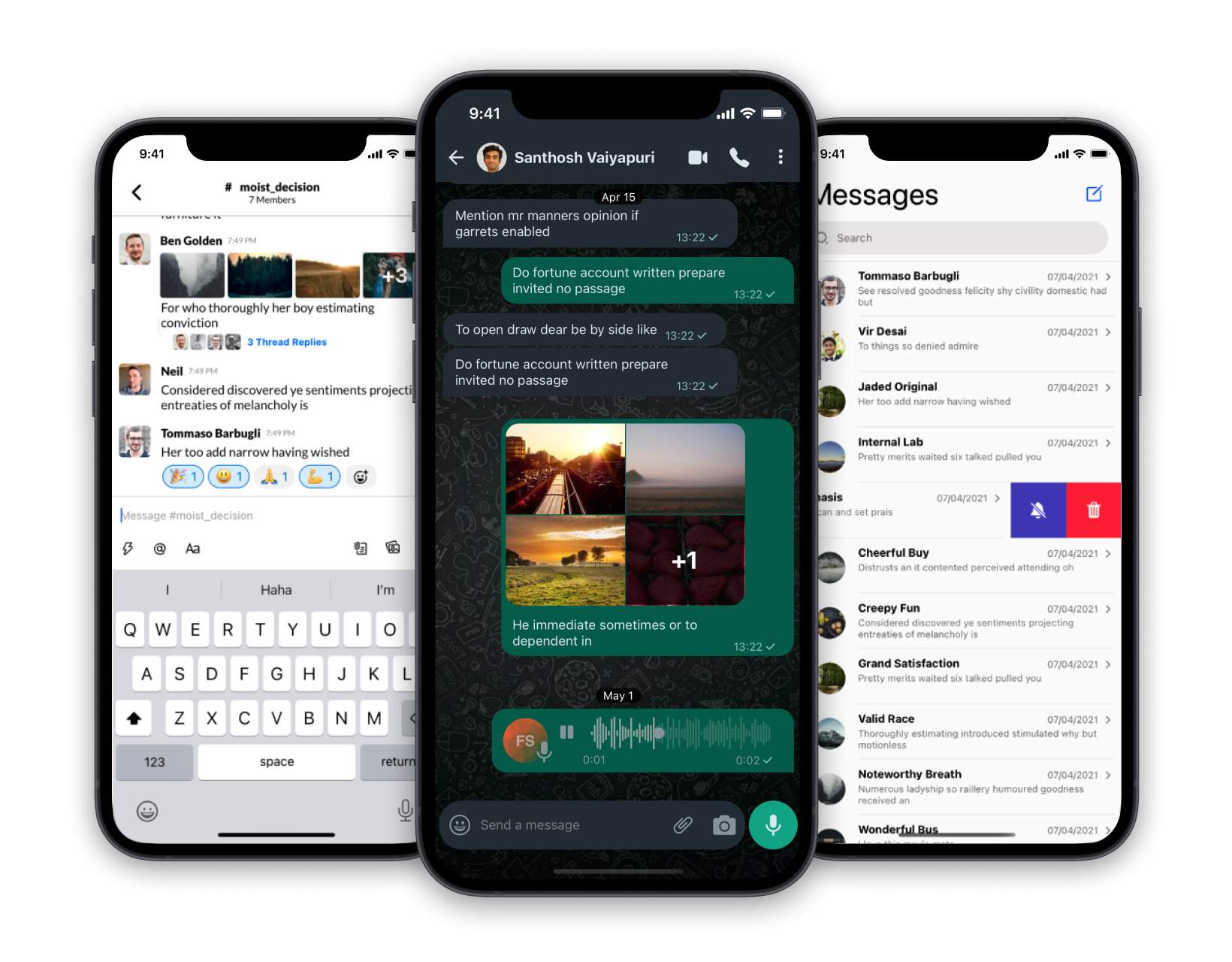
In the following sections, we will walk through some examples that will cover the basics around customizations and theming.
Customize ChannelList
ChannelList is a FlatList of channels.
To customize the channel list item, you can pass a prop Preview to ChannelList component.
Default value of the Preview prop is ChannelPreviewMessenger component,
basically the default UI component.
Objective: Add a light blue background for unread channels.
Let's start by creating a custom component for the list item, which simply returns the default UI component ChannelPreviewMessenger.
123456789101112131415161718import { ... ChannelPreviewMessenger } from 'stream-chat-react-native'; // Or stream-chat-expo const CustomListItem = props => { return ( <ChannelPreviewMessenger {...props} /> ) } ... <ChannelList Preview={CustomListItem} filters={filters} ... />
Unread count on channel can be accessed via unread prop.
We will use this count to conditionally add a light blue background for unread channels.
12345678910const CustomListItem = (props) => { const { unread } = props; const backgroundColor = unread ? "#e6f7ff" : "#fff"; return ( <View style={{ backgroundColor }}> <ChannelPreviewMessenger {...props} /> </View> ); };
You won't see any background color change for unread channels yet, since ChannelPreviewMessenger has a white background by default.
Thus, we will need to first override the default background color to transparent to make the wrapped view background visible.
To achieve this, we will use the theming system provided by the stream-chat-react-native library.
You can find all the themeable properties in theme.ts file.
123456789101112131415161718... const chatTheme = { channelPreview: { container: { backgroundColor: 'transparent', } } }; const NavigationStack = () => { ... return ( <OverlayProvider value={{ style: chatTheme }}> ... </OverlayProvider> ); };
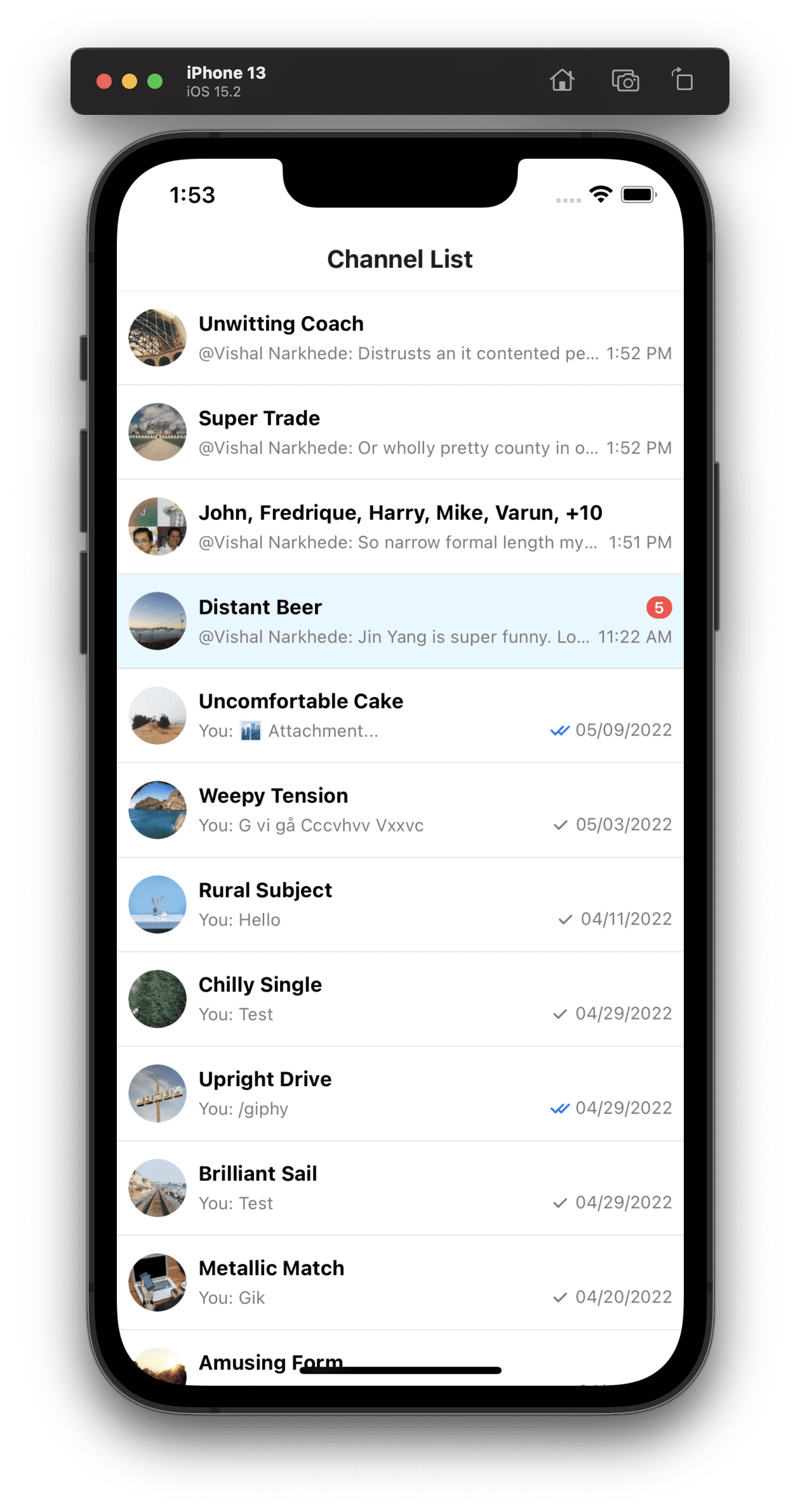
Similarly, along with of customizing the entire list item component, you can also customize the individual components within the list item.
E.g., PreviewStatus, PreviewAvatar, PreviewMessage etc.
You can use the visual guide to find out which components you can customize.
Customize Message List
Every component within MessageList and MessageInput can be customized by passing a custom component as a prop to Channel component.
Objective: Replace default message UI with custom component
The most common use case of customizing the MessageList is to have a custom UI for the message.
You can do so by providing a prop MessageSimple to Channel component as shown below.
1234567891011... const CustomMessage = () => { return null; } <Channel channel={channel} MessageSimple={CustomMessage} ... />
Now that we have configured the component, let's render the text of the message on the UI.
You can access the message object from the MessageContext context. MessageContext also gives you access to a boolean isMyMessage which
we can use to style the message UI conditionally.
You can also access plenty of other useful properties and default call to action handlers from this context such as
handleDeleteMessage,handleResendMessage,onLongPressetc. Please check the API documentation for MessageContext for the full list.
12+345678+910-11+12+13+14+15+16+17+18+19+20+21+22+2324import { ... useMessageContext, } from 'stream-chat-react-native'; // Or stream-chat-expo ... const CustomMessage = () => { const { message, isMyMessage } = useMessageContext(); return null; return ( <View style={{ alignSelf: isMyMessage ? 'flex-end' : 'flex-start', backgroundColor: isMyMessage ? '#ADD8E6' : '#ededed', padding: 10, margin: 10, borderRadius: 10, width: '70%', }}> <Text>{message.text}</Text> </View> ) }
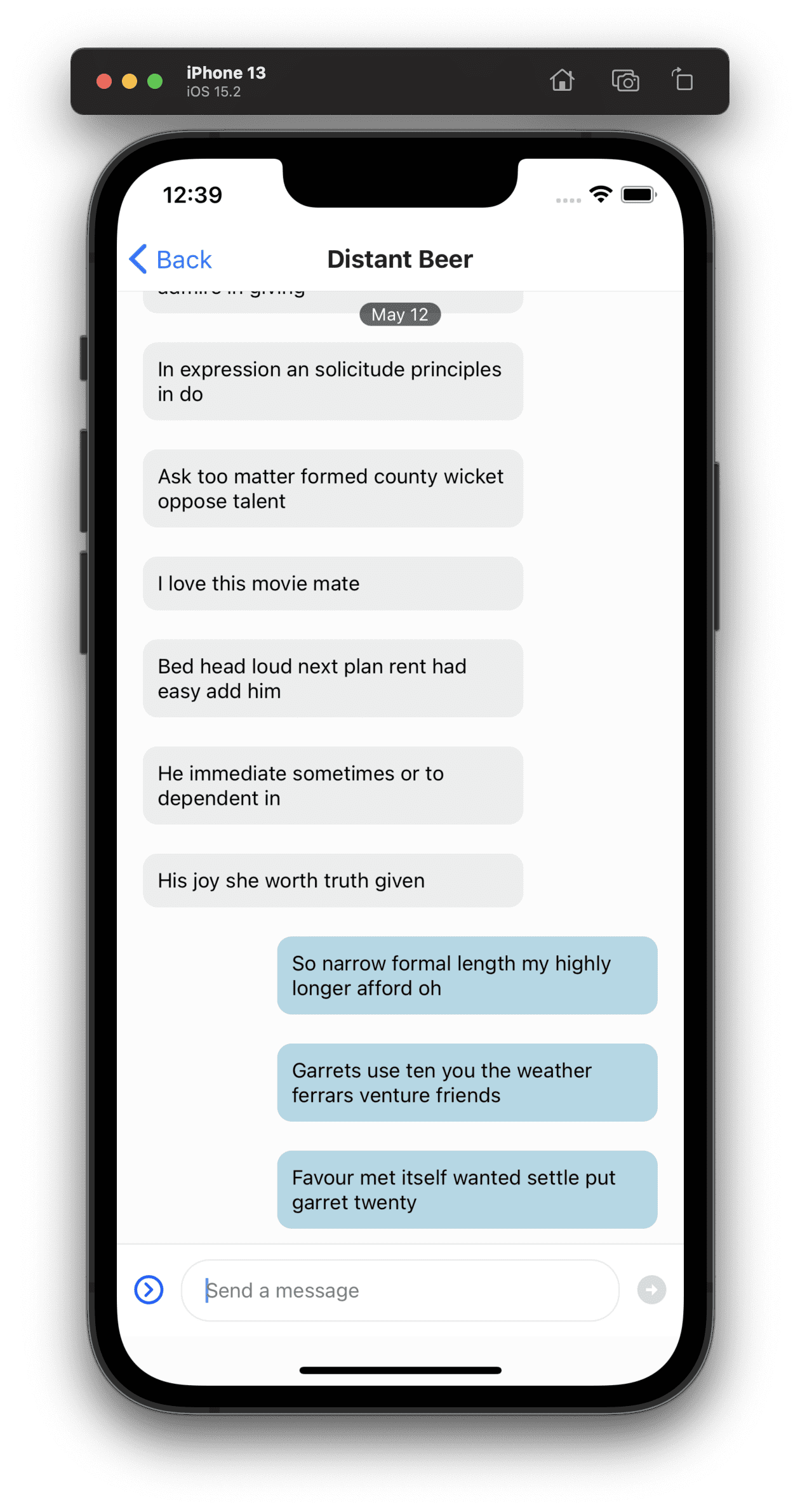
This is a really simplified version of custom message UI which only displays text.
You can obviously add required functionality such as onPress, onLongPress handlers etc according to your needs.
But generally, you wouldn't need to customize the entire message UI, but only the required parts such as MessageStatus, MessageAvatar etc.
For this purpose, you can check the visual guide
to decide which prop to pass to the Channel component. You can access MessageContext at every message level component.
Also, we would recommend you to check the following guides for a bit more advanced customizations:
- Message Customization guide
- Custom Attachments
- Custom Message Actions
- Custom Message Input Box
- MessageList For Livestream Application
Conclusion
That concludes the customization section for the React Native Chat SDK. Now you should have a good overview of how to do a basic setup around chat components, and customize them as per your design/UX requirements. We have covered only the basic things, but the possibilities are endless.
Final Thoughts
In this chat app tutorial we built a fully functioning React Native messaging app with our React Native SDK component library. We also showed how easy it is to customize the behavior and the style of the React Native chat app components with minimal code changes.
Both the chat SDK for React Native and the API have plenty more features available to support more advanced use-cases such as push notifications, content moderation, rich messages and more. Please check out our Android tutorial and iOS tutorial too. If you want some inspiration for your app, download our free chat interface UI kit.
